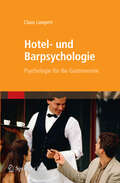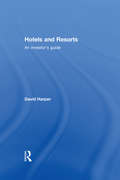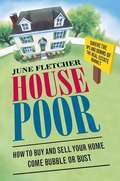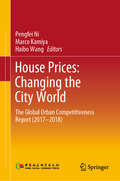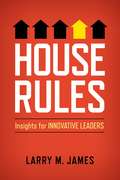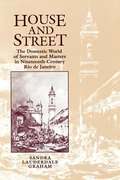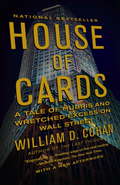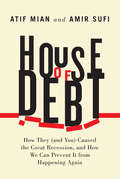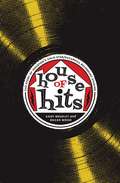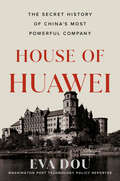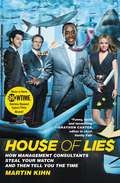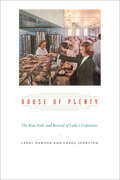- Table View
- List View
Hotel- und Barpsychologie: Psychologie für die Gastronomie
by Claus LampertHotel- und Barpsychologie, was ist denn das? Der Diplom Psychologe und Psychologische Psychotherapeut Claus Lampert stellte als Pionier auf dem Gebiet der Hotel- und Barpsychologie fest, dass sich im Gastronomie Bereich viele Mitarbeiter für psychologische Zusammenhänge interessieren. So vermittelt dieses abbildungsreiche Lehrbuch branchenrelevante fundierte psychologische Grundkenntnisse und bietet zahlreiche praktische und alltagsrelevante Übungen, die dazu anregen, die Sichtweise auf das Arbeitsfeld und sich selbst zu hinterfragen. Dieses Werk ist ein kompaktes Lehrbuch für Auszubildende, sowie ein Begleitbuch für die Fort- und Weiterbildung, wie auch eine faszinierende und spannende Lektüre für alle diejenigen, die ihre Kompetenzen und ihr Wissen in diesem Bereich erweitern wollen.
Hotels and Resorts: An investor's guide
by David HarperHotels and Resorts: An investor's guide presents a comprehensive analysis of how hotels, golf courses, spas serviced apartments, gyms and health clubs and resorts are developed, operate and are valued. Drawing on over 18 years’ experience in the leisure property industry, David Harper provides invaluable advice on how to buy, develop and sell such properties. Working through the required due diligence process for purchases, including how to identify a "good buy", through the "route map" for a successful development and ending with how to ensure you maximise your returns when selling the asset, this book covers the whole life-cycle of leisure property ownership. Examples of valuations, development issues and sales processes are taken from the USA, UK, France, Nigeria, Kenya, Australia, Hong Kong, Singapore and Brazil provide in depth analysis on the similarities and differences in approach to hotels and resorts in various parts of the world. This book provides invaluable guidance to international investors, developers, asset managers and students in related subject areas.
Hotelverträge (essentials)
by Clemens Engelhardt Büşra ÖzdemirIn diesem essential erhält der Leser einen Überblick über gängige Hotelbetreiberverträge wie Miete, Pacht, Management, Franchise und deren jeweilige Wirkweise. Die Vertragsinhalte werden prägnant und praxisnah erläutert und bildlich dargestellt.
Hotstar
by Krishna G. Palepu Kairavi DeyHotstar was an online video streaming platform owned by Star India Private Limited, a wholly owned subsidiary of the Walt Disney Corporation. Since its launch in 2015, the platform had grown to offer over 100,000 hours of TV content, movies in nine Indian languages and live coverage of popular sporting events to its 300 million viewers. Although most of Hotstar's content was offered as a free advertisement-based service, users could access exclusive movies and TV shows by paying for a monthly or annual subscription plan. Hotstar's appealing content and high-quality technology made it one of the most popular video streaming apps but it now faced increasing competition from both domestic and foreign players. The company also had to accelerate the conversion of customers who used the free advertising-based streaming service to a subscription based streaming service. At the same time, there was a need to create more unique content leveraging its digital platform, as opposed to repurposing the content created for broadcast TV for digital streaming. Given all these challenges, the company's CEO Uday Shankar wondered, how should Hotstar evolve in order for it to become a profitable and sustainable business in the next few years?
Houghton Mifflin Harcourt
by Stuart C. Gilson Sarah L. AbbottOne of the leading publishers of textbooks and other educational materials for the U.S. K-12 educational instruction market has suffered a dramatic decline in sales and profits in the wake of the 2008-2009 financial market crisis and economic recession and is now overburdened with debt. To regain its competitiveness, the company has to significantly reduce its debt by billions of dollars. Company management is trying to decide which of several options is best for achieving this goal, including filing for Chapter 11 bankruptcy, restructuring its debt out-of-court, or filing a "pre-packaged" Chapter 11 bankruptcy.
Housatonic Partners--ArchivesOne, Inc.
by Michael J. Roberts Nabil N. El-HageDescribes Housatonic Partners' investment in ArchivesOne, a records management company. The original investment was made in 1998, and subsequent investments are made by Housatonic. In 2005, as the life of the investment fund is coming to an end, Housatonic must work with management to decide when and how to exit.
Housatonic Partners--ArchivesOne, Inc.
by Michael J. Roberts Nabil N. El-HageDescribes Housatonic Partners' investment in ArchivesOne, a records management company. The original investment was made in 1998, and subsequent investments are made by Housatonic. In 2005, as the life of the investment fund is coming to an end, Housatonic must work with management to decide when and how to exit.
House Poor
by June FletcherThe housing market, like any other investment, has always had its ups and downs. But ever since it started its upswing at the beginning of this decade, the ride has become more thrilling--and more dangerous. One day, home values are skyrocketing and cheap money is up for grabs; the next day, houses linger on the market and interest rates rise alarmingly high. Home buyers and sellers are beginning to recognize that however the market moves where they live, they must be prepared to make smart housing decisions. Written by veteran real estate reporter June Fletcher, House Poor teaches you everything you need to know to weather the ups and downs of the housing market, including: How to tell whether your hometown is likely to boom or bust When to take equity out of your house How to buy as a first-time home owner or as an investor during turbulent times How to protect your home investment When and how to sell your home Today's volatile housing market could make you house poor. This book will keep you house proud.
House Price Developments in Europe: A Comparison
by Alexander W. Hoffmaister Paul Hilbers Angana Banerji Haiyan ShiA report from the International Monetary Fund.
House Prices: The Global Urban Competitiveness Report (2017–2018)
by Pengfei Ni Marco Kamiya Haibo WangThis report was jointly launched by the National Academy of Economic Strategy of the Chinese Academy of Social Sciences and UN-HABITAT. Using the indicator system and objective data, the competitiveness of 1,035 global cities was evaluated in detail. The report measures the development pattern of global urban competitiveness as a whole, and the gap between the relevant parties and the ideal state. It has refreshed people's past perceptions of urban rankings and confirmed that the science and technology innovation center cities and central cities of emerging economies have begun to break the inherent global cities and they have entered the ranks of the most urban competitiveness.While paying attention to the comparison of competitiveness among cities, this report further promotes the perspective to the pattern and trend change of global economic and social development from the perspective of city. The followings are new findings: First, information technology has increasingly become the primary driving force for urban development; Second, it is the three meridians that divide the global urban population and economic differentiation; Third, the soft links between cities gradually dominate the global urban system; Fourth, the formation of new global cities is beginning.
House Rules: Insights for Innovative Leaders
by Larry M. JamesMove from vision to reality. In House Rules, Larry shares essential, on the-ground leadership principles for environments as diverse as board rooms, public housing developments, hunger relief efforts, and donor cultivation. In an accessible and conversational style, he examines practical, instructive case studies and offers principled guidance for leaders in any management setting that calls for execution and action. A great resource for leadership development and motivation, House Rules will inspire leaders to face the daunting challenges ahead and expect big results.
House Signs and Collegiate Fun: Sex, Race, and Faith in a College Town
by Chaise LadousaIt's no secret that fun is important to American college students, but it is unusual for scholars to pay attention to how undergraduates represent and reflect on their partying. Linguist and anthropologist Chaise LaDousa explores the visual manifestations of collegiate fun in a Midwestern college town where house signs on off-campus student residences are a focal point of college culture. With names like Boot 'N Rally, The Plantation, and Crib of the Rib, house signs reproduce consequential categories of gender, sexuality, race, and faith in a medium students say is benign. Through his analysis of house signs and what students say about them, LaDousa introduces the reader to key concepts and approaches in cultural analysis.
House and Street: The Domestic World of Servants and Masters in Nineteenth-century Rio de Janeiro
by Sandra Lauderdale GrahamThe Brazilian women of 19th century worked as housemaids either as slaves or free. House and Street re-creates the working and personal lives of these women.
House of Cards: A Tale of Hubris and Wretched Excess on Wall Street
by William D. CohanOn March 5, 2008, at 10:15 A. M. , a hedge fund manager in Florida wrote a post on his investing advice Web site that included a startling statement about Bear Stearns & Co. , the nation's fifth-largest investment bank: "In my book, they are insolvent. " This seemed a bold and risky statement. Bear Stearns was about to announce profits of $115 million for the first quarter of 2008, had $17. 3 billion in cash on hand, and, as the company incessantly boasted, had been a colossally profitable enterprise in the eighty-five years since its founding. Ten days later, Bear Stearns no longer existed, and the calamitous financial meltdown of 2008 had begun. How this happened - and why - is the subject of William D. Cohan's superb and shocking narrative that chronicles the fall of Bear Stearns and the end of the Second Gilded Age on Wall Street. Bear Stearns serves as the Rosetta Stone to explain how a combination of risky bets, corporate political infighting, lax government regulations and truly bad decision-making wrought havoc on the world financial system. Cohan's minute-by-minute account of those ten days in March makes for breathless reading, as the bankers at Bear Stearns struggled to contain the cascading series of events that would doom the firm, and as Treasury Secretary Henry Paulson, New York Federal Reserve Bank President Tim Geithner, and Fed Chairman Ben Bernanke began to realize the dire consequences for the world economy should the company go bankrupt. But HOUSE OF CARDS does more than recount the incredible panic of the first stages of the financial meltdown. William D. Cohan beautifully demonstrateswhythe seemingly invincible Wall Street money machine came crashing down. He chronicles the swashbuckling corporate culture of Bear Stearns, the strangely crucial role competitive bridge played in the company's fortunes, the brutal internecine battles for power, and the deadly combination of greed and inattention that helps to explain why the company's leaders ignored the danger lurking in Bear's huge positions in mortgage-backed securities. The author deftly portrays larger-than-life personalities like Ace Greenberg, Bear Stearns' miserly, take-no-prisoners chairman whose memos about re-using paper clips were legendary throughout Wall Street; his profane, colorful rival and eventual heir Jimmy Cayne, whose world-champion-level bridge skills were a lever in his corporate rise and became a symbol of the reasons for the firm's demise; and Jamie Dimon, the blunt-talking CEO of JPMorgan Chase, who won the astonishing endgame of the saga (the Bear Stearns headquarters alone were worth more than JP Morgan paid for the whole company). Cohan's explanation of seemingly arcane subjects like credit default swaps and fixed- income securities is masterful and crystal clear, but it is the high-end dish and powerful narrative drive that makes HOUSE OF CARDS an irresistible read on a par with classics such as LIAR'S POKER and BARBARIANS AT THE GATE. Written with the novelistic verve and insider knowledge that made THE LAST TYCOONS a bestseller and a prize-winner, HOUSE OF CARDS is a chilling cautionary tale about greed, arrogance, and stupidity in the financial world, and the consequences for all of us.
House of Cards: The Inside Story of the Fall of Custom House Capital (Penguin Specials)
by Niall BradyIn the summer of 2011, investors with Custom House Capital - some of whom had all their pension savings tied up with the investment house - faced a nightmare: the possibility that their money was gone, and that they wouldn't be getting it back. Finance journalist Niall Brady takes us behind the scenes for the first in-depth account of a disaster that has cost investors millions. He shows how clients' funds were mis-allocated to cover losses, how the Financial Regulator, though aware of irregularities at CHC for years, failed to forestall the crisis, and how it remains unclear, over a year after the scandal was uncovered, whether people will get their money back. His account of the strange culture and practices of CHC makes House of Cards a must-read for fans of Too Big to Fail and The Big Short.Niall Brady is a chartered accountant and a journalist with the Sunday Times.'Damning ... Brady tells the tale of how the rogues still run rings around the protectors' Shane Ross, Sunday Independent'One of the most shocking stories to have emerged in Ireland's economic bust' Cantillon, Irish Times'Excellent concise read. Great story' Tom Lyons, author of The FitzPatrick Tapes
House of Debt: How They (and You) Caused the Great Recession, and How We Can Prevent It from Happening Again
by Atif Mian Amir Sufi<p>The Great American Recession resulted in the loss of eight million jobs between 2007 and 2009. More than four million homes were lost to foreclosures. Is it a coincidence that the United States witnessed a dramatic rise in household debt in the years before the recession―that the total amount of debt for American households doubled between 2000 and 2007 to $14 trillion? Definitely not. Armed with clear and powerful evidence, Atif Mian and Amir Sufi reveal in <i>House of Debt</i> how the Great Recession and Great Depression, as well as the current economic malaise in Europe, were caused by a large run-up in household debt followed by a significantly large drop in household spending. <p>Though the banking crisis captured the public’s attention, Mian and Sufi argue strongly with actual data that current policy is too heavily biased toward protecting banks and creditors. Increasing the flow of credit, they show, is disastrously counterproductive when the fundamental problem is too much debt. As their research shows, excessive household debt leads to foreclosures, causing individuals to spend less and save more. Less spending means less demand for goods, followed by declines in production and huge job losses. How do we end such a cycle? With a direct attack on debt, say Mian and Sufi. More aggressive debt forgiveness after the crash helps, but as they illustrate, we can be rid of painful bubble-and-bust episodes only if the financial system moves away from its reliance on inflexible debt contracts. As an example, they propose new mortgage contracts that are built on the principle of risk-sharing, a concept that would have prevented the housing bubble from emerging in the first place. <p>Thoroughly grounded in compelling economic evidence, <i>House of Debt</i> offers convincing answers to some of the most important questions facing the modern economy today: Why do severe recessions happen? Could we have prevented the Great Recession and its consequences? And what actions are needed to prevent such crises going forward?</p>
House of Debt: How They (and You) Caused the Great Recession, and How We Can Prevent It from Happening Again
by Atif Mian Amir SufiThe Great American Recession resulted in the loss of eight million jobs between 2007 and 2009. More than four million homes were lost to foreclosures. Is it a coincidence that the United States witnessed a dramatic rise in household debt in the years before the recession—that the total amount of debt for American households doubled between 2000 and 2007 to $14 trillion? Definitely not. Armed with clear and powerful evidence, Atif Mian and Amir Sufi reveal in House of Debt how the Great Recession and Great Depression, as well as the current economic malaise in Europe, were caused by a large run-up in household debt followed by a significantly large drop in household spending. Though the banking crisis captured the public’s attention, Mian and Sufi argue strongly with actual data that current policy is too heavily biased toward protecting banks and creditors. Increasing the flow of credit, they show, is disastrously counterproductive when the fundamental problem is too much debt. As their research shows, excessive household debt leads to foreclosures, causing individuals to spend less and save more. Less spending means less demand for goods, followed by declines in production and huge job losses. How do we end such a cycle? With a direct attack on debt, say Mian and Sufi. More aggressive debt forgiveness after the crash helps, but as they illustrate, we can be rid of painful bubble-and-bust episodes only if the financial system moves away from its reliance on inflexible debt contracts. As an example, they propose new mortgage contracts that are built on the principle of risk-sharing, a concept that would have prevented the housing bubble from emerging in the first place. Thoroughly grounded in compelling economic evidence, House of Debt offers convincing answers to some of the most important questions facing the modern economy today: Why do severe recessions happen? Could we have prevented the Great Recession and its consequences? And what actions are needed to prevent such crises going forward?
House of Hits
by Andy Bradley Roger WoodFounded in a working-class neighborhood in southeast Houston in 1941, Gold Star/SugarHill Recording Studios is a major independent studio that has produced a multitude of influential hit records in an astonishingly diverse range of genres. Its roster of recorded musicians includes Lightnin’ Hopkins, George Jones, Willie Nelson, Bobby “Blue” Bland, Junior Parker, Clifton Chenier, Sir Douglas Quintet, 13th Floor Elevators, Freddy Fender, Kinky Friedman, Ray Benson, Guy Clark, Lucinda Williams, Beyoncé and Destiny’s Child, and many, many more. In House of Hits, Andy Bradley and Roger Wood chronicle the fascinating history of Gold Star/SugarHill, telling a story that effectively covers the postwar popular music industry. They describe how Houston’s lack of zoning ordinances allowed founder Bill Quinn’s house studio to grow into a large studio complex, just as SugarHill’s willingness to transcend musical boundaries transformed it into of one of the most storied recording enterprises in America. The authors offer behind-the-scenes accounts of numerous hit recordings, spiced with anecdotes from studio insiders and musicians who recorded at SugarHill. Bradley and Wood also place significant emphasis on the role of technology in shaping the music and the evolution of the music business. They include in-depth biographies of regional stars and analysis of the various styles of music they represent, as well as a list of all of Gold Star/SugarHill’s recordings that made the Billboard charts and extensive selected historical discographies of the studio’s recordings.
House of Huawei: Inside the Secret World of China's Most Powerful Company
by Eva DouThe untold story of the mysterious company that shook the world'Authoritative... a tale that sits at the heart of the most significant geopolitical relationship today' Financial Times'Explosive' Sunday Times'Groundbreaking' Dan Wang'Riveting, robustly researched' TLS 'Essential reading' Chris Miller, author of Chip WarOn the coast of southern China, an eccentric entrepreneur spent three decades steadily building an obscure telecom company into one of the world's most powerful technological empires with hardly anyone noticing. This all changed in December 2018, when the detention of Meng Wanzhou, Huawei Technologies' female scion, sparked an international hostage standoff, poured fuel on the U.S.-China trade war, and suddenly thrust the mysterious company into the international spotlight.In House of Huawei, Washington Post technology reporter Eva Dou pieces together a remarkable portrait of Huawei's reclusive founder Ren Zhengfei and how he built a sprawling corporate empire - one whose rise Western policymakers have become increasingly obsessed with halting. The book dissects the global web of power, money, influence, surveillance, bloodshed and national glory that Huawei helped to build - and that has also ensnared it.Based on wide-ranging interviews and painstaking archival research, House of Huawei tells an epic story of familial and political intrigue that presents a fresh window on China's rise from third-world country to U.S. rival, and shines a clarifying light on the security considerations that keep world leaders up at night.House of Huawei holds a mirror up to one of the world's most mysterious companies as never before.
House of Huawei: The Secret History of China's Most Powerful Company
by Eva Dou&“Authoritative… a tale that sits at the heart of the most significant geopolitical relationship today.&” – Financial Times &“There&’s probably no better account of China&’s rise to economic dominance as seen through the prism of a single company.&” – The Wall Street Journal ABOUT THE BOOK The untold story of the mysterious company that shook the world.On the coast of southern China, an eccentric entrepreneur spent three decades steadily building an obscure telecom company into one of the world&’s most powerful technological empires with hardly anyone noticing. This all changed in December 2018, when the detention of Meng Wanzhou, Huawei Technologies&’ female scion, sparked an international hostage standoff, poured fuel on the US-China trade war, and suddenly thrust the mysterious company into the global spotlight.In House of Huawei, Washington Post technology reporter Eva Dou pieces together a remarkable portrait of Huawei&’s reclusive founder, Ren Zhengfei, and how he built a sprawling corporate empire—one whose rise Western policymakers have become increasingly obsessed with halting. Based on wide-ranging interviews and painstaking archival research, House of Huawei dissects the global web of power, money, influence, surveillance, bloodshed, and national glory that Huawei helped to build—and that has also ensnared it.
House of Lies: How Management Consultants Steal Your Watch and Then Tell You the Time
by Martin KihnIn the bestselling tradition of "Liar's Poker" comes a devastatingly accurate and darkly hilarious behind-the-scenes look at the wonderful world of management consulting.
House of Plenty: The Rise, Fall, and Revival of Luby's Cafeterias
by Carol Dawson Carol JohnstonScarred by the deaths of his mother and sisters and the failure of his father’s business, a young man dreamed of making enough money to retire early and retreat into the secure world that his childhood tragedies had torn from him. But Harry Luby refused to be a robber baron. Turning totally against the tide of avaricious capitalism, he determined to make a fortune by doing good. Starting with that unlikely, even naive, ambition in 1911, Harry Luby founded a cafeteria empire that by the 1980s had revenues second only to McDonald’s. So successfully did Luby and his heirs satisfy the tastes of America that Luby’s became the country’s largest cafeteria chain, creating more millionaires per capita among its employees than any other corporation of its size. Even more surprising, the company stayed true to Harry Luby’s vision for eight decades, making money by treating its customers and employees exceptionally well. Written with the sweep and drama of a novel, House of Plenty tells the engrossing story of Luby’s founding and phenomenal growth, its long run as America’s favorite family restaurant during the post–World War II decades, its financial failure during the greed-driven 1990s when non-family leadership jettisoned the company’s proven business model, and its recent struggle back to solvency. Carol Dawson and Carol Johnston draw on insider stories and company records to recapture the forces that propelled the company to its greatest heights, including its unprecedented practices of allowing store managers to keep 40 percent of net profits and issuing stock to all employees, which allowed thousands of Luby’s workers to achieve the American dream of honestly earned prosperity. The authors also plumb the depths of the Luby’s drama, including a hushed-up theft that split the family for decades; the 1991 mass shooting at the Killeen Luby’s, which splattered the company’s good name across headlines nationwide; and the rapacious over-expansion that more than doubled the company’s size in nine years (1987–1996), pushed it into bankruptcy, and drove president and CEO John Edward Curtis Jr. to violent suicide. Disproving F. Scott Fitzgerald’s adage that “there are no second acts in American lives,” House of Plenty tells the epic story of an iconic American institution that has risen, fallen, and found redemption—with no curtain call in sight.
House of Plenty: The Rise, Fall, and Revival of Luby's Cafeterias
by Carol Dawson Carol JohnstonScarred by the deaths of his mother and sisters and the failure of his father's business, a young man dreamed of making enough money to retire early and retreat into the secure world that his childhood tragedies had torn from him. But Harry Luby refused to be a robber baron. <P><P>Turning totally against the tide of avaricious capitalism, he determined to make a fortune by doing good. Starting with that unlikely, even naive, ambition in 1911, Harry Luby founded a cafeteria empire that by the 1980s had revenues second only to McDonald's. So successfully did Luby and his heirs satisfy the tastes of America that Luby's became the country's largest cafeteria chain, creating more millionaires per capita among its employees than any other corporation of its size. Even more surprising, the company stayed true to Harry Luby's vision for eight decades, making money by treating its customers and employees exceptionally well.
House of Quality
by Don Clausing John R. HauserManufacturing companies striving to compete on quality must design products that not only are technically elegant and manufacturable but also reflect customers' desires and tastes. For optimal results, marketers, designers, engineers, and strategists should work closely together from product conception to end result. A Japanese innovation, the house of quality, can help get interfunctional-team conversations started. Presented here in clear, step-by-step exhibits, the house is a conceptual map on which interdisciplinary teams can display and organize the evidence they need to set targets for design. Once all relevant facts are on the grid, the team makes its choices. The process has clarified opportunities, stimulated negotiation, and helped set an agenda. And the format is flexible. Once engineering targets have been set, the team can draw up new houses.
